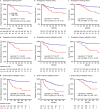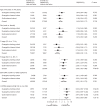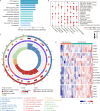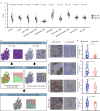A lncRNA signature associated with tumor immune heterogeneity predicts distant metastasis in locoregionally advanced nasopharyngeal carcinoma
- PMID: 35637194
- PMCID: PMC9151760
- DOI: 10.1038/s41467-022-30709-6
A lncRNA signature associated with tumor immune heterogeneity predicts distant metastasis in locoregionally advanced nasopharyngeal carcinoma
Abstract
Increasing evidence has revealed the roles of long noncoding RNAs (lncRNAs) as tumor biomarkers. Here, we introduce an immune-associated nine-lncRNA signature for predicting distant metastasis in locoregionally advanced nasopharyngeal carcinoma (LA-NPC). The nine lncRNAs are identified through microarray profiling, followed by RT-qPCR validation and selection using a machine learning method in the training cohort (n = 177). This nine-lncRNA signature classifies patients into high and low risk groups, which have significantly different distant metastasis-free survival. Validations in the Guangzhou internal (n = 177) and Guilin external (n = 150) cohorts yield similar results, confirming that the signature is an independent risk factor for distant metastasis and outperforms anatomy-based metrics in identifying patients with high metastatic risk. Integrative analyses show that this nine-lncRNA signature correlates with immune activity and lymphocyte infiltration, which is validated by digital pathology. Our results suggest that the immune-associated nine-lncRNA signature can serve as a promising biomarker for metastasis prediction in LA-NPC.
© 2022. The Author(s).
Conflict of interest statement
The authors declare no competing interests.
Figures






Similar articles
-
Development and validation of a gene expression-based signature to predict distant metastasis in locoregionally advanced nasopharyngeal carcinoma: a retrospective, multicentre, cohort study.Lancet Oncol. 2018 Mar;19(3):382-393. doi: 10.1016/S1470-2045(18)30080-9. Epub 2018 Feb 7. Lancet Oncol. 2018. PMID: 29428165
-
Plasma protein-based signature predicts distant metastasis and induction chemotherapy benefit in Nasopharyngeal Carcinoma.Theranostics. 2020 Aug 1;10(21):9767-9778. doi: 10.7150/thno.47882. eCollection 2020. Theranostics. 2020. PMID: 32863958 Free PMC article.
-
Immune-related long noncoding RNA signature for predicting survival and immune checkpoint blockade in hepatocellular carcinoma.J Cell Physiol. 2020 Dec;235(12):9304-9316. doi: 10.1002/jcp.29730. Epub 2020 Apr 24. J Cell Physiol. 2020. PMID: 32330311
-
Comprehensive analysis of recently discovered lncRNA-associated competing endogenous RNA network in nasopharyngeal carcinoma.Pathol Res Pract. 2024 Jun;258:155314. doi: 10.1016/j.prp.2024.155314. Epub 2024 Apr 16. Pathol Res Pract. 2024. PMID: 38696855 Review.
-
Emerging roles of lncRNA in Nasopharyngeal Carcinoma and therapeutic opportunities.Int J Biol Sci. 2022 Mar 28;18(7):2714-2728. doi: 10.7150/ijbs.70292. eCollection 2022. Int J Biol Sci. 2022. PMID: 35541920 Free PMC article. Review.
Cited by
-
Genetic variants of LncRNAs HOTTIP and MEG3 influence nasopharyngeal carcinoma susceptibility and clinicopathologic characteristics in the Southern Chinese population.Infect Agent Cancer. 2024 Jul 24;19(1):32. doi: 10.1186/s13027-024-00591-6. Infect Agent Cancer. 2024. PMID: 39049088 Free PMC article.
-
Mapping Non-Coding RNAs in Space and Time: Another Weapon to Dissect Intra-Tumor Heterogeneity in Cancer Progression.Cancers (Basel). 2023 Jun 14;15(12):3181. doi: 10.3390/cancers15123181. Cancers (Basel). 2023. PMID: 37370791 Free PMC article.
-
Prognostic value and immune landscapes of disulfidptosis‑related lncRNAs in bladder cancer.Mol Clin Oncol. 2024 Dec 13;22(2):19. doi: 10.3892/mco.2024.2814. eCollection 2025 Feb. Mol Clin Oncol. 2024. PMID: 39776943 Free PMC article.
-
Development of Prognostic Nomogram Based on Lipid Metabolic Markers and Lactate Dehydrogenase in Non-Metastatic Nasopharyngeal Carcinoma.J Inflamm Res. 2023 Jul 24;16:3093-3107. doi: 10.2147/JIR.S416801. eCollection 2023. J Inflamm Res. 2023. PMID: 37520664 Free PMC article.
-
Risk model based on minichromosome maintenance 2 using objective assessment for predicting survival of neuroblastoma.iScience. 2023 Jan 13;26(2):105974. doi: 10.1016/j.isci.2023.105974. eCollection 2023 Feb 17. iScience. 2023. PMID: 36756367 Free PMC article.
References
Publication types
MeSH terms
Substances
LinkOut - more resources
Full Text Sources
Molecular Biology Databases

